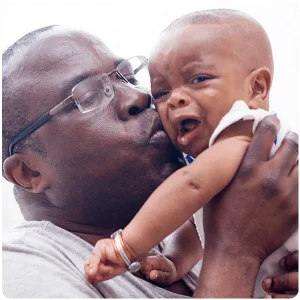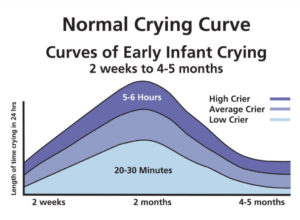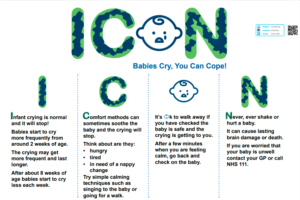Coping with Crying Babies

![]()
It is hard for parents and carers to cope with a crying baby. At its very worst, a baby’s crying can make a person feel like they are living on a cliff edge and completely out of control. Stress, depression, feelings of helplessness and inadequacy, and the urge to shake a baby may be triggered by crying and it is important to know where to get help in these situations.
A baby’s crying will normally hit its peak at around 6-8 weeks:

Abusive Head Trauma
It is imperative that a parent/carer does not shake a baby when they feel they are living on a cliff edge. This can lead to something called Abusive Head Trauma that can do catastrophic damage to a baby’s brain. Studies have shown that 70% of Abusive Head Trauma injuries in babies are caused by males, and that there is a link between Abusive Head Trauma in babies and the 6-8-week crying peak (see above). Please see below for further information on Abusive Head Trauma.
ICON
ICON is a simple message that has been designed for parents to work through a baby’s crying and to offer specific advice on what to do if a baby’s crying is getting too much. ICON stands for:

The message reinforces that it is OK to say when a baby’s crying becomes too much. Merton GPs, midwives, health visitors, and a range of other professionals have been trained to share ICON with parents and carers. Please do not hesitate to get in contact with them if you are struggling to cope. To find out more about ICON, please see the information below or follow this link to the ICON Parents’ Advice Webpage
I Am Unshakeable Video
The following video illustrates, through the voice of a dad, what living on a cliff edge means.
“C” is for Comfort Methods
Try some of the comforting methods below. Remember, not all of them will work, but that’s OK.
![]()
Who to call when it gets tough.
If you are in a situation where a baby’s crying is making you feel out of control, please call your medical professional or make use of any of these helplines. Talking to someone will help:
- Mental Health Helpline for Urgent Help – NHS (www.nhs.uk)
- Helplines and listening services – Mind
- Contact Us | Samaritans
What is abusive head trauma (AHT)
- ‘Shaken baby syndrome’
- Child abuse
- Catastrophic injuries:
- Bleeds in the brain and behind eyes
- Fractures
- Babies can be shaken, thrown or hit
- It affects approximately 24 of every 100,000 babies admitted to hospital each year
- Research suggests one in nine mothers may have shaken their baby and up to two in nine felt like doing so.
Who shakes and why?
- 70% perpetrators are males – fathers/male surrogates (Kesler et al., 2008; Altman et al., 2010)
- Can occur in every socio-economic group
- Coping with crying: Living on the edge
- Caregivers lose control and shake – baby stops crying
- Demonstrable relationship between the normal peak of crying and babies subject to AHT (Barr et al., 2006)
- Increase in cases in the first month of life, a peak at six weeks during the second month and a decrease during the third to fifth months of life
Triggers
- Crying is considered the main trigger
- Peak of crying is six to eight weeks of age
- The parents or the mothers partner are responsible for AHT in 75% of babies
- The majority of perpetrators are male
- The most at risk groups are:
- Male baby
- Below 6 months
- Low birth weight
- Regular contact with health professional
ICON is a public health programme that has been designed to help any person caring for babies to cope with periods of crying. ICON stands for:
I – Infant crying is normal and it will stop
C – Comforting methods can help
O – It’s OK to walk away
N – Never, ever shake a baby
The idea for the ICON programme and the different interventions within it was conceived by Dr Suzanne Smith PhD following a study of effective interventions and research into the prevention of Abusive Head Trauma (AHT). Research suggests that some lose control when a baby’s crying becomes too much. Some go on to shake a baby with devastating consequences. Suzanne found that the most effective evidence-based programmes studied provide a simple message that supports parents/care givers to cope with infant crying. Apart from preventing AHT, most people who have ever cared for a baby appreciate some advice about how to comfort a crying baby and how to cope when it goes on for a long time.
For more information regarding ICON, please visit the official ICON website
Ellis’ Story
Documenting the story of Ellis, who was, very sadly, shaken by his father. This video is distressing and viewer caution is advised.
Shaken Inside Out Video
A short documentary about parents who have experienced the “cliff edge.”
The ICON Parents’ Advice Webpage
This features a range of information videos including:
- The Crying Graph Info Video
- Dads, Please Talk Video
- Deep Breathing Video
- Ways to Cope Video
- Dads, Talk Earlier Video
